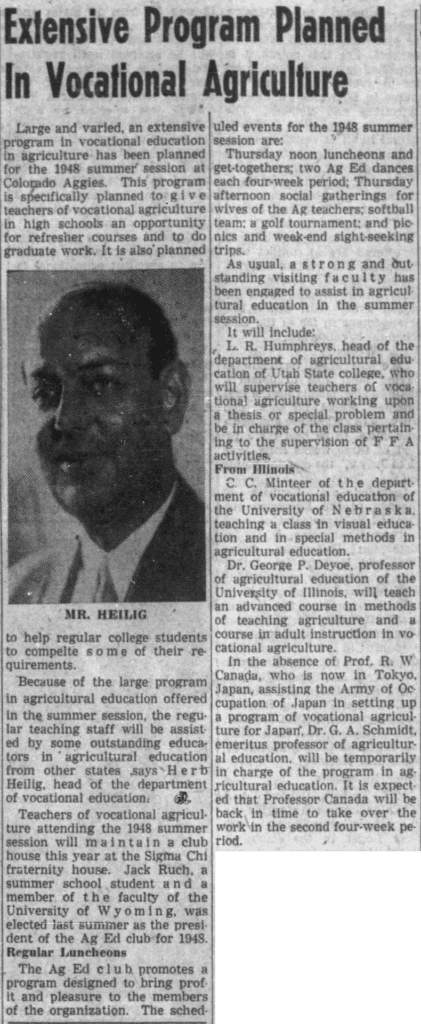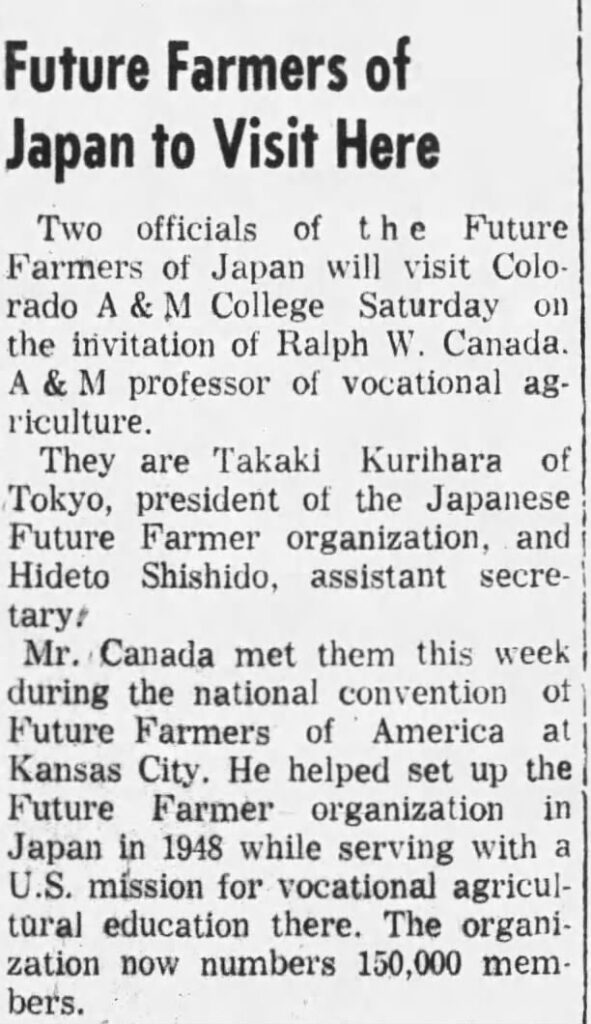Our journey through the states finds us in Colorado this week. Colorado affiliated with the National FFA Organization in 1929 and received National Charter 15 (follow this link to see the charter application). In 2021-22 Colorado had 126 FFA chapters and 8,334 members. The web site for the Colorado FFA is https://www.coloradoffa.org/.
In this Footnote there will be several mentions of Colorado State University. It was founded as Colorado Agricultural College in 1870, renamed in 1935 to Colorado State College of Agriculture and Mechanical Arts, and renamed Colorado State University in 1957. To make reading easier, I will just call it Colorado State or Colorado State University.
The Rural School Visitor
Did your state have a rural school visitor in the early 1900s? Colorado did!
At the annual meeting of County School Superintendents in 1910 a resolution was passed asking the General Assembly to appropriate funds to employ a Rural School Visitor to be housed at the state agricultural college. The idea was the Visitor could work with County School Superintendents to strengthen the work of the rural schools.
C. S. Sargent, School Superintendent in Mesa county, assumed the position in 1912 after the state legislature appropriated funds to support the position. He visited schools with the county superintendents and developed plans for school improvement. Some of the recommendations had to do with school consolidation. He also promoted forge and carpentry work along with the teaching of agriculture, domestic science, and manual training in the rural schools. See Figure 1 for more information.

Figure 1. From The Fort Collins Express & The Fort Collins Review, October 17, 1912
Rocky Mountain High – Summer School in Colorado
How would you like to spend time during the summer in the Rocky Mountains? If you were an agricultural teacher in the first half of the 1900s you could easily justify doing so. The Colorado Agricultural College, now known as Colorado State University, offered summer school classes for agriculture teachers, home economics teachers, trade and industrial arts teachers, plus other related fields. In 1937 courses were added for extension workers.
The summer school faculty was composed of faculty from Colorado plus nationally known scholars and practitioners in vocational education from across the United States. The summer school program was recognized as the premier vocational education training event in America.
In 1934 there were 534 teachers in the summer school from all vocational fields which was a 33% increase from the previous year. During the summer of 1935 ninety vocational agriculture teachers from 18 different states were in attendance. G. A. Schmidt, Head of the agricultural education program at Colorado State, was expecting over 200 vocational agriculture teachers in 1937. Total enrollment from all vocational fields in 1937 approached 1,600.
Teachers attending the summer school could sharpen their teaching skills and could also earn a Master’s degree. Three-fourths of the agriculture teachers were pursuing a master’s degree. A teacher could earn a master’s degree in three summers. Of the 35 credits required, 21 were earned in residence, 10 hours could be transferred from recognized institutions, and 4 credits were given for writing a thesis.
The faculty for the summer school varied from year to year. In 1937 the Colorado State faculty was augmented with 60 visiting educators. Nationally known vocational educators such as Charles Prosser, Charles Allen, Robert Selvidge, Theodore Struck, Ada Hart Arlitt, Kate Kenyon, and Thomas Quigley were some of the visiting faculty. The visiting faculty literally were the Who’s Who of American Vocational Education.
In 1936 there were 18 agricultural education instructors from 10 states and Washington, DC. Some of the Ag Ed instructors were:
- W. A. Ross – Executive Secretary of the FFA
- R. B. Jeppson – State Supervisor, Montana
- Frank Wimberly – State Supervisor, New Mexico
- J. B. Perkey – State Supervisor, Oklahoma
- Leroy Clements – State Supervisor, Nebraska
- R. J. Palmer – Teacher Educator, Montana
- L. D. Klemmedson – Teacher Educator, Arizona
- G. A. Schmidt – Teacher Educator, Colorado
If we were to fast forward to 1951 the agricultural education faculty included:
- R. W. Canada, Colorado State University
- John Bicknell, Research Director of the Iowa State Education Association
- E. J. F. Early, Colorado State University
- Kenneth Nelson, Michigan State University
- Joe Duck, University of Missouri
- Henry Brunner, Department Head at Pennsylvania State College
- John McClelland, Head of Agricultural Education at Iowa State
In the early days, the agricultural teachers in attendance at the summer school were often initiated into Alpha Tau Alpha (ATA), the agricultural education honorary. A. W. Nolan of the University of Illinois was responsible for starting this honorary in the early 1920s. In order to spread information about ATA and expand the membership across the country, it made sense to initiate new members who were in attendance at the summer school.
When you were not in class you could go sightseeing, fishing, mountain climbing, picnicking, or be engaged in a variety of other social and recreational activities. One feature of the summer school was the Ag Ed Club. This was the organization for agriculture teachers attending the summer school. The club sponsored a number of social and recreational activities. There were even special events for the Ag Ed wives. In a 1951 article in the Fort Collins Coloradoan (May 22, p, 70A) we learn:
The Ag Ed club will again provide enjoyable events for its members, Mr. Canada said, Softball, dancing, horseback riding, golf and Thursday noon luncheons featuring outstanding speakers will highlight the events.
There were softball tournaments among the various vocational disciplines. Typically the agricultural teachers won over their arch nemesis – the industrial arts teachers.

Figure 2. Fort Collins Coloradoan, April 14, 1937

Figure 3. Fort Collins Coloradoan, May 8. 1948. Take special note in the last paragraph that Dr. Canada is in Japan setting up a program of vocational agriculture. More about that in a bit.
They Got the Message
In the early days of the FFA a familiar phrase was “Of the Students, By the Students, and For the Students.” This meant the FFA was a student organization and should be run by the students. Sometimes, I think agriculture teachers forget this.
When I found this 1963 article about the Palisades High School agriculture program, it made my heart feel good – for two reasons. First, the agriculture teacher said “the boys learn to accept responsibility and make decisions.“ These were not idle words. The chapter operated a “hog chain” and there was a chapter livestock committee to make sure the hogs were being cared for properly. There was an instance when the committee decided to remove a hog from a student. It was not a decision made by the teacher. The article states “It was a hard decision for the boys to make, but they made it unassisted.” (To learn more about livestock chains such as this see the Friday Footnote for 5/3/2019.)
The second reason I liked this article was the headline that the vo ag program did more than train students for farming. The Vocational Education Act of 1963 which broadened the scope of vocational agriculture to be more than farming was signed into law on December 18 of 1963. The article about Palisades was written in February of 1963. This agriculture program was ahead of the curve. (See Figure 4).

Figure 4. The Daily Sentinel (Grand Junction), February 17, 1963
Give Credit Where Credit is Due
In the publication FFA at 50 written by A. W. Tenney he writes (p. 119):
George Lewis, former national president of the FFA made a report at the 1951 FFA convention on his visit with the Future Farmers of Japan. It was reported that Ivan Nelson, a former teacher of vocational agriculture attached to General McArthur’s staff in the Army of Occupation, had been influential in the development of the Future Farmers of Japan.
Several current scholars in the field have cited Ivan Nelson as being instrumental in establishing the Future Farmers of Japan. It appears the basis for this statement is based upon the above quote from the FFA at 50 publication. However, more detailed research might be needed.
The obituary for Ralph Canada who was head of agricultural education at Colorado State University from 1945 until he retired in 1968 contains this statement (Fort Collins Coloradoan, November 22, 1984, p. 16):
He was a consultant in 1948 with the U.S. State Department and was assigned to Gen. Douglas McArther’s staff in Tokyo, where he started the Future Farmers of Japan.
Hmm! So was it Ivan Nelson or Ralph Canada who established the Future Farmers of Japan? Or was it both? The claim for Ralph Canada might be bolstered by an article in the Fort Collins Coloradoan in 1956. It was reported that two officials from the Future Farmers of Japan were going to visit Colorado State on the invitation of Ralph Canada who helped set up the Future Farmers of Japan. See Figure 5.
Furthermore, in an article in The Agricultural Education Magazine published in 1958 (November, p. 119) we learn that currently “Dr. Canada is a member of a team of educators studying the vocational education needs of Italy, Greece, and Turkey” and was “Assistant State Supervisor of Agricultural Education in charge of Food Production War Training from ’41 to ’45; County Rehabilitation Supervisors for the U.S.D.A. in 1941, and consultant in vocational agriculture with headquarters in Tokyo, Japan, during 1948.” Dr. Canada did have considerable international and war related experiences and was in Japan when the FFJ was established.

Figure 5. From the Fort Collins Coloradoan, October 19, 1956
Ag Teacher Shortage
When was the last time a newspaper article appeared in a newspaper in your state reporting on the agriculture teacher shortage? Perhaps it would be a good idea.
In 1976 the Colorado Springs Gazette-Telegraph reported on the agriculture teacher shortage nationally and in Colorado. Irving Cross, a teacher educator at Colorado State University was interviewed for the article. At the end of the article contact information for Dr. Cross was given. See Figure 6.

Figure 6. from the Colorado Springs Gazette-Telegraph, December 17, 1976
Concluding Remarks
One of the many phrases attributed to Dr. Seuss is “Oh, the stuff you will learn.” That is certainly true of this series of alphabetical Footnotes focused on the states. I have learned a lot! So what have I learned from the Colorado Footnote? Here are some observations:
- I had never heard of a Rural School Visitor before writing this Footnote After learning of such a person, a little digging finds Rural School Visitors in Illinois, Kansas, and Missouri.
- I was aware of the Colorado State Summer School program but had no idea about the scope of the program or the details. It was a big thing.
- It was refreshing to learn of a school where FFA members actually made important decisions.
- I have not seen many articles in newspapers about the agriculture teacher shortage. It was nice to see such an article. We tell each other there is a shortage, but have we adequately informed the public?
- It is time to recognize Ralph Canada for his role in starting the Future Farmers of Japan. When we report on historical matters it is best to use more than just one source of information.
So what did you learn from this Footnote?
